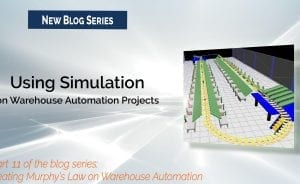
View original at blogs.dcvelocity.com
Most companies that have attempted to implement automated materials handling equipment have discovered that these projects can be particularly vulnerable to Murphy’s Law, the principal that, “anything that can go wrong, will go wrong.” This blog is eleventh in an ongoing series on “Beating Murphy’s Law in Warehouse Automation Projects.” Blog 11 DC One key way to mitigate risk is to spend “Smart Money" on key technologies like system simulation. Simulation software differs from other forms of data modeling in some significant ways. Simulation software allows actual material handling equipment to be built with defined performance parameters and logic models, which simulate the decisions that are made by the controls software as various inputs are received. Graphical layouts are created which show what the equipment looks like in 3D renderings. Both mechanical as well as human work rates can be defined and modeled. A material handling system can be virtually “built”, and the software can simulate the picking, packing, and shipping of actual sales orders both by human and mechanized processes. Some of the key questions that simulation software can often answer include: How will the system respond if last Wednesday’s sales orders were processed through it? How would the system respond if the orders from the busiest day last year were processed through it? What bottlenecks exist in the system? What would happen if a key component in the system failed? What if we grouped orders in batches like this? How quickly can the system process them? If we don’t have the labor perfectly balanced across zones, what level of labor imbalance will make the system choke? What happens if the shipping area falls behind for “x” minutes? At what point does the system back up and shut down the picking area? Will it be possible to replenish […]



Leave a Reply
You must be logged in to post a comment.